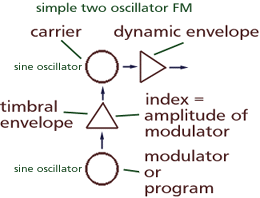in linear
or digital systems which use sine waves, the sidebands
or additional tones which are generated as the index changes from 0 are
predictable and coherent.
if the modulator frequency is sub-audio we refer to this phenomenon
as vibrato. by using envelopes to control the amplitude of the carrier
and the modulator it is possible to create a vary diverse range of sounds
using linear FM. |

FM was made popular in the academic world by composer John Chowning
and in the world of popular culture by Yamaha who bought the rights to
FM from Chowning and developed a large series of digital synthesizers based
on this synthesis algorithm.
(DX7, TX802, TX81Z, etc.) |